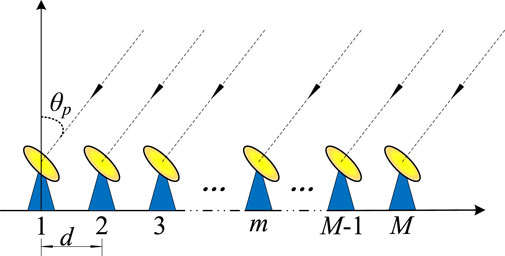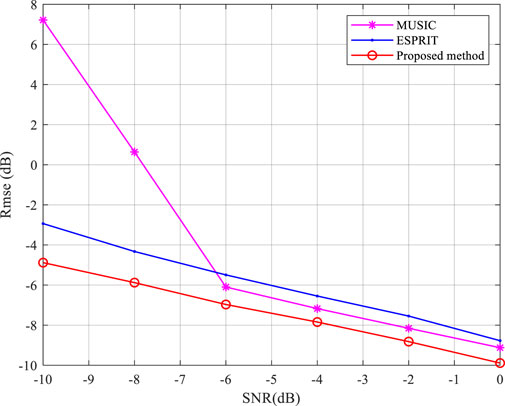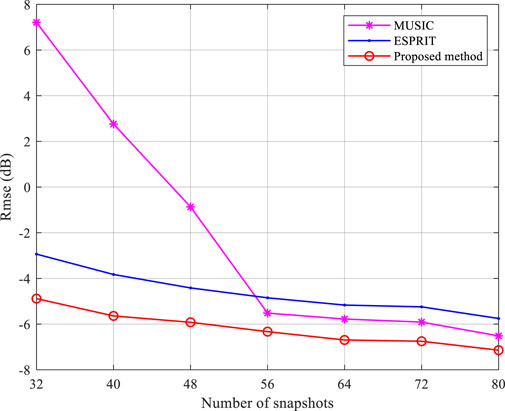- 1School of Electronic Engineering, Xidian University, Xi’an, China
- 2Key Laboratory for Radar Signal Processing, Xidian University, Xi’an, China
Direction Of Arrival (DOA) of signals detection technology is an important vehicle in the field of in remote sensing, radar, wireless communication. In this study, we elaborate on an enhanced method to detect the DOA. In the developed scheme, we mainly focus on solving the steering matrix of the array which contains all the information of the signals. The iterative relation between the steering matrix and the signal vector is first established on the basis of the equation of the array output. Then, to get a more accurate of steering matrix, we construct a cost function that aims to minimize some signal subspace error. In the optimization process of the developed scheme, we also set a constraint for the steering matrix which can effectively eliminate convergence on local optimum and also reduce the number of iterations. Subsequently, the steering matrix of the array can be recovered faithfully. Finally, the DOA can be solved from the estimated steering matrix. Explicit analysis and derivation of the proposed scheme are presented.
Introduction
Array signal processing is an indispensable technique in signal processing with ubiquitous applications [1, 2]. The Direction Of Arrival (DOA) detection technology is a very popular topic in array signal processing [3, 4] in the field of in remote sensing, radar, wireless communication, etc. High-resolution subspace-based DOA methods have attracted considerable attention concerning the accurate detection of the DOA from observations of array output. The most representative high-resolution subspace-based approaches are the MUltiple SIgnal Classification (MUSIC) [5] and the Estimation Signal Parameter via Rotational Invariance Techniques (ESPRIT) [6]. The MUSIC method detects the DOA based on the orthogonality between the signal subspace and noise subspace [7, 8], and the ESPRIT algorithm builds on the rotational invariance of signal subspaces [9, 10]. The detection performance of this type of methods mainly depends on the accuracy of the signal subspace. Thus, how to capture a high-precision signal subspace has always been the pursuit of these approaches [11, 12].
In this study, we design an enhanced scheme for the DOA detection. During the design process, a cost function by minimizing some signal subspace error is established to optimize the steering matrix of the array [13, 14]. In the optimization, a constraint is set to converge rapidly and eliminate converging on local optimum. Ultimately, the DOA can be solved from the obtained steering matrix of the array. We provide a series of simulations to demonstrate the superiority of the proposed method. To the best of our knowledge, the idea in this paper has not been considered in previous studies.
The organization of the paper reflects the key phases of the design process. The array signal model is first presented to formulate the problem. Next, we develop an enhanced DOA detection scheme through optimization of the steering matrix of the array. This is followed by the experimental results. Conclusions are covered in the last section.
Problem formulation
Without loss of generality, in this letter, we use a Uniform Linear Array (ULA) to illustrate the array signal model for DOA detection. We consider P narrow band noncoherent far field signals
where
where T stands for the transpose operation, d denotes the spacing between adjacent antenna elements, λ and θp are the wavelength and the pth DOA of the signals, respectively. The array signal model is shown in Figure 1.
The high-resolution subspace-based approaches detect the DOA based on the accurate signal and the noise subspaces. Normally, the signal and the noise subspaces can be achieved through the Eigen decomposition of the array output covariance matrix [17]. Theoretically, the Eigen decomposition of the array output covariance matrix is computed in the following manner
where H stands for the complex conjugate transpose,
where
Most of the existing subspace-based methods enhance the DOA detection performance through solving or optimizing an accurate signal subspace, which has always been a hot topic for scholars [18].
Optimization of the signal subspace
Based on the above array signal model, in this section, we develop a novel optimization scheme of the signal subspace. Mathematically, the detection of the DOA can be considered as the solution of the steering matrix of the array, and the corresponding problem is formulated as
where
It seems that the steering matrix of the array can be obtained in the above way (iteratively update the steering matrix and the signal vector). However, the array output contains not only signals but also noises, minimizing the standard squared error of (5) to produce the steering matrix is probably not desirable. To capture an accurate steering matrix so as to solve the DOA of the signals, we carry out the following design.
Assume that the steering matrix of the array computed by minimizing some cost function during the iteration is
and the projection matrix [19, 20] of the signal subspace is defined as
Ideally, this reconstructed signal subspace and the estimated signal subspace through the covariance matrix of the array output should be equal. Thus, from this point of view, we establish such a cost function
and combine it with (5) to optimize the signal subspace to determine the DOA.
Proceeding with more details, the developed scheme starts by computing the covariance matrix of the array output. Then, a set of initial DOAs is estimated using some classical approaches (say, MUSIC, ESPRIT, etc.) to form an initial steering matrix of the array
In order to avoid the algorithm falling into a local optimum, we set a constraint for the steering matrix of the array. Let
That is, during the iteration process, we limit the steering matrix of the array to a certain range by keeping the DOA to be detected to a certain range, which can effectively eliminate convergence on local optimum and also reduce the number of iterations of the algorithm. Obviously, this strategy can not only ensure the detection accuracy of DOA, but also accelerate the convergence speed of the method.
Experimental studies
We offer a series of simulations to demonstrate the Root-Mean-Square Error (RMSE) [20] performance of the approach compared with the MUSIC and the ESPRIT methods. In all simulations, a 15 elements ULA with a relative interelement spacing of d = λ/2 is used, and four narrowband signals with the DOAs [5°, 10°, 15°, 30°] impinge on the array. In this letter, the RMSE is defined as [21, 22].
where N denotes the independent trials, and in the following simulations we set it as 200;
First, we test the RMSE performance of the methods versus the SNR, where the number of snapshots is fixed at 32, and the SNR varies from −10 to 0 with two intervals. The means of the simulation results are plotted in Figure 2. It is apparent that the performance of DOA detection is enhanced compared with the MUSIC and the ESPRIT methods with the developed method, and the developed method is also not very sensitive to the low SNR.
After that, we test the RMSE performance of the methods versus the number of snapshots. In the simulation, the SNR is fixed as −10 dB, and the number of snapshots varies from 32 to 80 with eight intervals. Figure 3 shows the simulation results. It is noticeable that the proposed method outperforms the MUSIC method and becomes insensitive to the changes of the number of snapshots. As previously mentioned in this letter, the detection performance of these subspace-based methods mainly depends on the accuracy of the signal subspace. The developed scheme optimizes the signal subspace through constructing a cost function and determining an optimal solution of the steering matrix of the array so as to solve the DOA. During this process, the signal subspace is optimized and the performance of the DOA detection becomes enhanced.
Conclusion
A scheme for DOA detection is put forward in this paper. The proposed scheme mainly involves the construction of the cost function of the steering matrix and the design of the steering matrix optimization. A constraint for the steering matrix is also set to make the method converge fast and eliminate the convergence on local optimum. The DOA is solved from the resulting steering matrix of the array. The simulation results indicate that the developed scheme achieves much better estimation performance than the traditional algorithms.
Hence, this paper proposes a fresh way to detect the DOA and also poses a problem of reducing the complexity of the method, as the developed scheme includes a series of iterations. Furthermore, hardware design and consideration of a real noise environment would also be interesting topics for research.
Data availability statement
The original contributions presented in the study are included in the article/supplementary material, further inquiries can be directed to the corresponding author.
Author contributions
All the authors made significant contributions to the work. The idea was proposed by GL; GX simulated the algorithm, analysed the data designed the experiments and polish the English, and wrote the paper. All authors have read and agreed to the published version of the manuscript.
Funding
This work was supported the National Natural Science Foundation of China under Grant 61971349.
Conflict of interest
The authors declare that the research was conducted in the absence of any commercial or financial relationships that could be construed as a potential conflict of interest.
Publisher’s note
All claims expressed in this article are solely those of the authors and do not necessarily represent those of their affiliated organizations, or those of the publisher, the editors and the reviewers. Any product that may be evaluated in this article, or claim that may be made by its manufacturer, is not guaranteed or endorsed by the publisher.
References
1. Ahmad Z. Fundamentals of narrowband array signal processing. In: W Cao, and Q Zhang, editors. Adaptive filtering-recent advances and practical implementation IntechOpen. Germany: Researchgate (2021). doi:10.5772/intechopen.98702
2. Wang M, Gao F, Jin S, Lin H. An overview of enhanced massive MIMO with array signal processing techniques. IEEE J Sel Top Signal Process (2019) 13(5):886–901. doi:10.1109/jstsp.2019.2934931
3. Liu H, Lu H, Lin J, Han F, Spencer BF, Cui J, et al. Penetration properties of ground penetrating radar waves through rebar grids. IEEE Geosci Remote Sensing Lett (2021) 18(7):1199–203. doi:10.1109/lgrs.2020.2995670
4. Duplouy J, Morlaas C, Aubert H, Potier P, Pouliguen P, Djoma C. Wideband and reconfigurable vector antenna using radiation pattern diversity for 3-D direction-of-arrival estimation. IEEE Trans Antennas Propagat (2019) 67(6):3586–96. doi:10.1109/tap.2019.2905729
5. Schmidt RO. Multiple emitter location and signal parameter estimation. IEEE Trans Antennas Propagat (1986) 34(3):276–80. doi:10.1109/tap.1986.1143830
6. Roy R, Kailath T. ESPRIT-estimation of signal parameters via rotational invariance techniques. IEEE Trans Acoust Speech, Signal Process (1989) 37(7):984–95. doi:10.1109/29.32276
7. Wang Z, Yang Z, Wu S, Li H, Tian S, Chen X. An improved multiple signal classification for nonuniform sampling in blade tip timing. IEEE Trans Instrum Meas (2020) 69(10):7941–52. doi:10.1109/tim.2020.2980912
8. Yang X, Wang K, Zhou P, Xu L, Liu J, Sun P, et al. Ameliorated-multiple signal classification (Am-MUSIC) for damage imaging using a sparse sensor network. Mech Syst Signal Process (2022) 163:108154–16. doi:10.1016/j.ymssp.2021.108154
9. Liu M, Cao H, Wu Y. Improved subspace-based method for 2-D DOA estimation with L-shaped array. Electron Lett (2020) 56(8):402–5. doi:10.1049/el.2019.4235
10. Xu KJ, Quan YH, Bie BW, Xing MD, Nie WK, Hanyu E. Fast direction of arrival estimation for uniform circular arrays with a virtual signal subspace. IEEE Trans Aerosp Electron Syst (2021) 57(3):1731–41. doi:10.1109/taes.2021.3050667
11. Xu KJ, Pedrycz W, Li ZW, Nie WK. High-accuracy signal subspace separation algorithm based on Gaussian kernel soft partition. IEEE Trans Ind Electron (2019) 66(1):491–9. doi:10.1109/tie.2018.2823666
12. Castanheira D, Gameiro A. Low Complexity and high-resolution line spectral estimation using cyclic minimization. IEEE Trans Signal Process (2019) 67(24):6285–300. doi:10.1109/tsp.2019.2953582
13. Wang X, Meng D, Huang M, Wan L. Reweighted regularized sparse recovery for DOA estimation with unknown mutual coupling. IEEE Commun Lett (2019) 23(2):290–3. doi:10.1109/lcomm.2018.2884457
14. Hu W, Wang Q. DOA estimation for UCA in the presence of mutual coupling via error model equivalence. IEEE Wireless Commun Lett (2020) 9(1):121–4. doi:10.1109/lwc.2019.2944816
15. Qin L, Wu S, Zhang C, Li X. Narrowband and full-angle refractive index sensor based on a planar multilayer structure. IEEE Sensors J (2019) 19(8):2924–30. doi:10.1109/jsen.2019.2890863
16. Ioushua SS, Yair O, Cohen D, Eldar YC. CaSCADE: Compressed carrier and DOA estimation. IEEE Trans Signal Process (2017) 65(10):2645–58. doi:10.1109/tsp.2017.2664054
17. Xu KJ, Nie WK, Feng DZ, Chen XJ, Fang DY. A multi-direction virtual array transformation algorithm for 2D DOA estimation. Signal Process. (2016) 125:122–33. doi:10.1016/j.sigpro.2016.01.011
18. Xu KJ, Xing M, Zhang R, Hanyu E, Sha MH, Nie WK, et al. High-accuracy DOA estimation algorithm at low SNR through exploiting a supervised index. IEEE Trans Aerosp Electron Syst (2022) 58(4):3658–65. doi:10.1109/taes.2022.3144121
19. Al-Sadoon MAG, Al-Nedawe BM, Bin-Melha M, Abd-Alhammed RA. The selected samples effect on the projection matrix to estimate the direction of arrival,” in Proceedings of the 2019 UK/China Emerging Technologies. Glasgow, UK, 21-22 August 2019, IEEE (2019). p. 1–5.
20. Ferreol A, Larzabal P, Viberg M. Performance prediction of maximum-likelihood direction-of-arrival estimation in the presence of modeling errors. IEEE Trans Signal Process (2008) 56(10):4785–93. doi:10.1109/tsp.2008.921794
21. Nie WK, Xu KJ, Feng DZ, Wu CQ, Hou AQ, Tin XY. A fast algorithm for 2D DOA estimation using an omnidirectional sensor array. Sensors (2017) 17(3):515–29. doi:10.3390/s17030515
Keywords: signal processing, direction of arrival (DOA), partial noise subspace, multiple signal classification (MUSIC), sensors
Citation: Xiao G and Liao G (2022) Enhancement of the DOA detection performance through optimization of the steering matrix of the array. Front. Phys. 10:1094638. doi: 10.3389/fphy.2022.1094638
Received: 10 November 2022; Accepted: 21 November 2022;
Published: 30 November 2022.
Edited by:
Huadan Zheng, Jinan University, ChinaReviewed by:
Ye Cui, University of Alberta, CanadaXiaoan Tang, Hefei University of Technology, China
Hengrong Ju, Nantong University, China
Copyright © 2022 Xiao and Liao. This is an open-access article distributed under the terms of the Creative Commons Attribution License (CC BY). The use, distribution or reproduction in other forums is permitted, provided the original author(s) and the copyright owner(s) are credited and that the original publication in this journal is cited, in accordance with accepted academic practice. No use, distribution or reproduction is permitted which does not comply with these terms.
*Correspondence: Guisheng Liao, bGlhb2dzQHhpZGlhbi5lZHUuY24=
 Guoyao Xiao
Guoyao Xiao Guisheng Liao1,2*
Guisheng Liao1,2*

